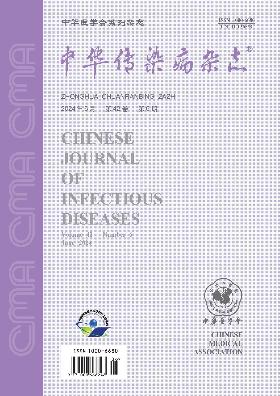Effect of auranofin combined with antineoplastic vorinostat on bactericidal activities against gram-negative bacteria and study on the target of auranofin
引用次数: 0
Abstract
Objective To find the target of auranofin with the antibacterial activity against gram-negative bacteria and to investigate the effect of the combination of auranofin and vorinostat on the antibacterial activity against gram-negative bacteria. Methods The strains of E. coli lacking thioredoxin reductase (TrxR) was used to find the target gene. The potential synergies of the combination of auranofin and vorinostat for E. coli strain, A. baumannii strain, P .aeruginosa strain, K. pneumonia strain and multidrug-resistant (MDR) A. baumannii strain were evaluated using susceptibility tests, micro-dilution checkerboard tests and time-kill studies. The genes related to Trx (trxA, trxB, trxC) and the gene expressed glutathione (gor) of E. coli BW25113 strains (WT) were separately knocked out to observe the effect of auranofin on minimum inhibitory concentration (MIC) and the time-kill kinetics of ΔtrxC and Δgor. Furthermore, the complemented strains (C-trxA, C-trxB, C-trxC, C-gor) were used to verify and define the genetic targets. Results According to the results of susceptibility tests, MICs of auranofin were 64 mg/L for E. coli strain BW25113 and K. pneumonia strain ATCC 43816, 128 mg/L for P. aeruginosa strain PA14 and 32 mg/L for both A. baumannii strain ATCC 17978 and A. baumannii strain AB5075. However, MICs of vorinostat are 512 mg/L for all isolates. The fractional inhibitory concentration indexes (FICIs) of the combination of auranofin and vorinostat for E. coli strain BW25113, A. baumannii strain ATCC 17978, MDR A. baumannii strain AB5075, K. pneumonia starin ATCC 43816 and P. aeruginosa strain PA14 were 0.313, 0.375, 0.375, 0.375, and 0.375, respectively, with all values <0.5, which showed synergy. In susceptibility tests of knockout strains, MICs of auranofin for ΔtrxC increased from 64 mg/L to 256 mg/L, decreased to 16 mg/L for Δgor, and no changes for ΔtrxA and ΔtrxB. Auranofin showed the same antibacterial activities against the complemented strains (C-trxC, C-gor) and E. col BW25113, which decreased by about 1.8 lg colong formins units (CFU)/mL of bacterial counts. However, the antibacterial activity of auranofin was significantly reduced for ΔtrxC, and decreased by<1 lg CFU/mL of bacterial counts. For Δgor, bacterial counts decreased 4.6 lg CFU/mL, and the antibacterial activity markedly increased. Conclusions The potential target gene of auranofin against gram-negative bacteria could be trxC, which provides new ideas and methods for the clinical treatment of multidrug-resistant gram-negative bacteria. Key words: Auranofin; Gram-negative bacteria; Thioredoxin reductase; Vorinostat; Synergy金糠芬联合抗肿瘤伏立诺他对革兰氏阴性菌的抑菌作用及靶菌的研究
目的探讨金糠蛋白对革兰氏阴性菌的抑菌活性,探讨金糠蛋白与伏立诺他合用对革兰氏阴性菌抑菌活性的影响。方法利用缺乏硫氧还蛋白还原酶(TrxR)的大肠杆菌菌株寻找靶基因。采用药敏试验、微量稀释棋盘棋盘试验和时间杀伤试验,评价了金嘌呤与伏立诺他联合用药对大肠杆菌、鲍曼不动杆菌、铜绿假单胞菌、肺炎克雷伯菌和多药耐药鲍曼不动杆菌的潜在协同作用。分别敲除大肠杆菌BW25113菌株(WT) Trx相关基因(trxA、trxB、trxC)和表达谷胱甘肽(gor)的基因,观察金糠蛋白对ΔtrxC和Δgor最低抑菌浓度(MIC)和时间杀伤动力学的影响。利用互补菌株(C-trxA、C-trxB、C-trxC、C-gor)验证和确定遗传靶点。结果药敏试验结果显示,金黄色葡萄蛋白对大肠杆菌BW25113和肺炎克雷伯菌ATCC 43816的mic值为64 mg/L,铜绿假单胞菌PA14的mic值为128 mg/L,鲍曼不动杆菌ATCC 17978和鲍曼不动杆菌AB5075的mic值为32 mg/L。伏立诺他的mic均为512 mg/L。金嘌呤与伏立诺他联用对大肠杆菌BW25113、鲍曼假单胞菌ATCC 17978、耐多药鲍曼假单胞菌AB5075、肺炎克雷伯菌ATCC 43816和铜绿假单胞菌PA14的分数抑制浓度指数(FICIs)分别为0.313、0.375、0.375、0.375,且均<0.5,表现出协同作用。在敲除菌株的药敏试验中,ΔtrxC对金毒苷的mic从64 mg/L增加到256 mg/L, Δgor对金毒苷的mic降低到16 mg/L, ΔtrxA和ΔtrxB对金毒苷的mic没有变化。金丝桃苷对互补菌株C-trxC、C-gor和大肠杆菌BW25113的抑菌活性相同,均降低约1.8个菌落单位(CFU)/mL。然而,对于ΔtrxC,金糠蛋白的抗菌活性明显降低,细菌计数下降<1 lg CFU/mL。对于Δgor,细菌计数降低4.6 lg CFU/mL,抗菌活性显著提高。结论金糠蛋白抗革兰氏阴性菌的潜在靶基因可能是trxC,为临床治疗多重耐药革兰氏阴性菌提供了新的思路和方法。关键词:萘醌;革兰氏阴性细菌;硫氧还蛋白还原酶;Vorinostat;协同作用
本文章由计算机程序翻译,如有差异,请以英文原文为准。
求助全文
约1分钟内获得全文
求助全文
来源期刊
自引率
0.00%
发文量
5280
期刊介绍:
The Chinese Journal of Infectious Diseases was founded in February 1983. It is an academic journal on infectious diseases supervised by the China Association for Science and Technology, sponsored by the Chinese Medical Association, and hosted by the Shanghai Medical Association. The journal targets infectious disease physicians as its main readers, taking into account physicians of other interdisciplinary disciplines, and timely reports on leading scientific research results and clinical diagnosis and treatment experience in the field of infectious diseases, as well as basic theoretical research that has a guiding role in the clinical practice of infectious diseases and is closely integrated with the actual clinical practice of infectious diseases. Columns include reviews (including editor-in-chief reviews), expert lectures, consensus and guidelines (including interpretations), monographs, short monographs, academic debates, epidemic news, international dynamics, case reports, reviews, lectures, meeting minutes, etc.

 求助内容:
求助内容: 应助结果提醒方式:
应助结果提醒方式:


